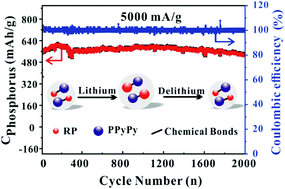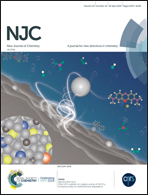A stable polypyridinopyridine–red phosphorus composite as a superior anode material for long-cycle lifetime lithium-ion batteries†
Abstract
Red phosphorus (RP) is an attractive anode material for lithium-ion batteries (LIBs) owing to its relatively low-cost and non-toxic nature. Here, we synthesize a novel polypyridinopyridine–red phosphorus (PPyPy–RP) composite containing phosphorus–carbon (P–C) and phosphorus–oxygen–carbon (P–O–C) bonds by a simple one-step vaporization–condensation–conversion method. The resultant PPyPy–RP composite has been investigated further as an anode material for LIBs, which exhibits a high discharge specific capacity of 1870.2 mA h gphosphorus−1 at 100 mA g−1 after 100 cycles. In the meantime, a stable discharge specific capacity of 518.3 mA h gphosphorus−1 within 2000 cycles is maintained at a higher current density of 5000 mA g−1. This superior performance is attributed to the structural stability of the chemically bonded PPyPy–RP composite, which plays an important role in maintaining contact between the P and conductive polypyridinopyridine (PPyPy) during the electrochemical process.



 Please wait while we load your content...
Please wait while we load your content...